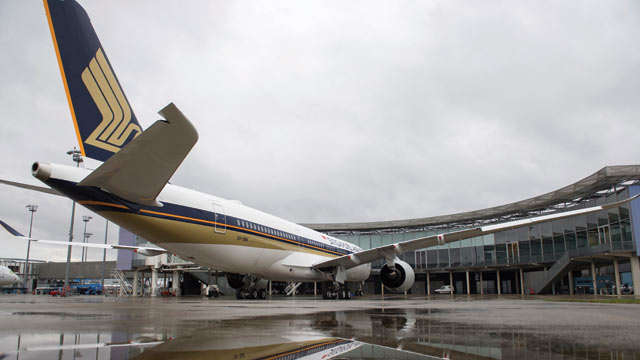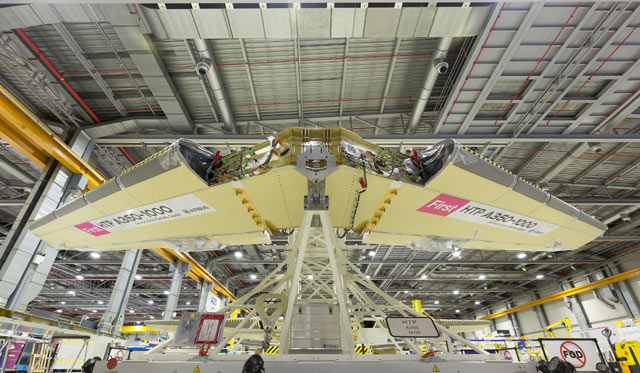Only one piece remains missing in the long-term portfolios of Airbus and Boeing widebody products as the two companies enter the Farnborough air show – and it could remain purposefully obscure for at least a while longer.
Boeing shifted the market for the upper-end of the twin-engined widebodies in November 2013 at the Dubai air show, launching the 777-9 as a re-engined and re-winged stretch of the franchise-leading, 350-seat 777-300ER, taking the seat count up by 50.
Ever since, Airbus has been trying to decide how to respond to the new competitive threat. The four-engined, long-range A340-600 was once offered in a three-class layout with 379 seats, but never found its footing in the market against the smaller, but more efficient 777-300ER. The A350-1000 is now taking shape within Airbus’s manufacturing system, but the 366-seater is scheduled to debut in 2017 in a capacity class one notch below the competition.
Studies have focused on what John Leahy, Airbus chief operating officer – customers, notionally describes as the “A350-2000”, a stretch of the already doubly-stretched A350-1000. Airbus originally launched the A350XWB family with the sidelined A350-800. The A350-900 debuted in service in January 2015, only four months after Airbus stopped development of the -800 variant, with a fuselage stretched by 6.26m (20.4ft). The A350-1000 adds nearly 7m to the overall fuselage length, requiring Airbus to integrate a six-wheeled landing gear and a 97,000lb-thrust version of the Rolls-Royce Trent XWB engine.
With the so-called A350-2000, Airbus is contemplating a third stretch of the fuselage cross-section introduced in 2006 with the A350-800. For Boeing, stretching the 777 beyond the -300ER variant required significant modification. Beyond simply a new centreline engine, Boeing added a fourth-generation wing designed using a carbon fibre-based composite material and incorporated electric and avionics systems developed for the 787. The 777-9 also includes interior changes, such as scalloped sidewalls to accommodate 10-abreast seating and a cabin pressurisation system retuned to provide a 6,300ft density altitude.

At least 50 A350-900s were due to be delivered this year, but less than a dozen have been handed over
Airbus
Airbus officials remain coy on the extent of the airframe, electronics and engine changes needed to launch a notional A350-2000, but insist the changes are less extensive than were required by Boeing for the 777X family.
“We don’t have to do as much work as Boeing would have to do. If we wanted to stretch the A350-1000 we would do it quite simply. The aircraft has the right wing, it has the right engine, it has the right fuselage width, it has all the right parameters today. So if our customers tell us that’s the airplane they want us to do, we will do it quite quickly,” says Kirin Rao, Airbus chief strategy officer.
The 777-9 is expected to be certificated in December 2019 before entering service in 2020. That leaves Airbus three-and-a-half years to launch and develop a direct response to Boeing’s 406-seat twin-jet.
Not surprisingly, Leahy would prefer a decision from Airbus’s board “sooner rather than later”, he told Flightglobal on the sidelines of the IATA general meeting in Dublin in early June. Last March, Leahy had indicated a decision on an A350-2000 could be announced at Farnborough in mid-July. But now he accepts a potentially more patient decision-making process, saying it does not matter to him if the matter is not decided until early next year.
For his part, Leahy’s boss, Airbus chief executive Fabrice Bregier, understands Leahy’s interest in a near-term decision, but seems even less committed to making an announcement at the UK airshow. Speaking at a press event in Hamburg, Germany, in late May, Bregier says he is “not optimistic” about a major product announcement at the Farnborough event.
“John is paid to push us. He wants more aircraft to be sold, and better and new versions and all that,” Bregier says. “We are studying that. We have to put many parameters together to launch a bigger plane.”
Some of those parameters may complicate Airbus’s launch decision. Over the past decade, the 777-300ER has enjoyed little direct competition in the 350-seat class of the market and has seen annual deliveries of about 100 aircraft. Since 2010, Boeing also has delivered another roughly 20 747-8 aircraft annually in the 405-seat class, including freighters and passenger airliners, although that number will be halved this year. Those three aircraft variants now account for a marketspace with annual demand for about 110-120 aircraft. Boeing also intends to preserve production of the 747-8F Freighter and the metal-winged 777 Freighter well beyond 2020, and plans to offer the 777-9 and 777-8 aircraft in that space. Finally, Airbus will introduce the A350-1000 in 2017. With so many models expecting to compete in that 350- to 406-seat segment, Airbus has some concerns about introducing yet another model.
“Will we sell more aircraft and how many more with a third member of the family, or is it what would you call cannibalisation? If it’s cannibalisation, you don’t do it because you don’t have a business case. If you know you can sell 500 more aircraft or 1,000 more aircraft or whatever you like for your investment, you take the appropriate decisions,” Bregier says.
At the same time, Bregier is careful to draw attention to Airbus’s doubts about Boeing’s widebody product strategy, suggesting the 777-9 was stretched to 406 seats perhaps not because of market demand, but because the weight of the metallic fuselage cross-section forced it to add more capacity in a bid to keep per-seat operating economics below the A350-1000’s.
Even Leahy, the consummate salesman, allows himself to doubt whether there truly is a market for a direct competitor to the 777-9, in addition to the A350-1000 at 366 seats. “Should we stretch the 350-1000? We’re debating that internally and talking to some of the industry, but I’m not convinced that the entire market just moved over [to 400 seats],” Leahy says. “Let’s say the market for the 777-300ER stays where it is – 1,000 airplanes at least. We’ve got an A350-1000 sitting there replacing all those 777-300ERs.”

A350-1000: already coming together for 2017
Airbus
In the meantime, Airbus has other priorities. The production ramp-up of the A350-900 is not going well. Airbus expects to deliver at least 50 A350-900s this year, but so far has delivered less than a dozen. Airbus blames suppliers of critical cabin equipment such as premium seating, lavatories and galleys for the delay, but insists the company will still meet the yearly delivery target.
The company is also deepening its product portfolio by tweaking existing variants to match niche airline requirements. The A350-900, for example, will be adapted for ultra-long-range missions for Singapore Airlines with a higher maximum take-off weight, so the aircraft can use the full volume of its fuel tanks. Performance upgrades also are under study for the A330-900, which is also set to appear in the market in 2017.
The missing piece in Airbus’s widebody portfolio remains an enigma, but it may be possible to discern which way the company is leaning amidst the order announcements and product updates at Farnborough. Bregier challenged Leahy to prove the business case for the A350-2000 by coming back with signed commitments, and there is no better opportunity than the year’s biggest air show.
“Let’s study where the market is and if John comes back with new airlines ready to sign [memoranda of understanding], binding commitments on that. We will see,” Bregier says. “The good news is we will know in these circumstances what to develop. And we would know we could develop it without huge investments.”
Get all the coverage from Farnborough Air Show on our dedicated landing page
Source: Cirium Dashboard











































